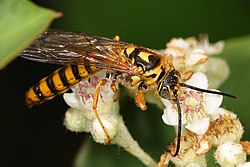| Thynnidae | |
|---|---|
 | |
| Male Elidothynnus melleus feeding on nectar | |
| Scientific classification | |
| Kingdom: | Animalia |
| Phylum: | Arthropoda |
| Class: | Insecta |
| Order: | Hymenoptera |
| Superfamily: | Thynnoidea |
| Family: | Thynnidae Shuckard, 1841 |
| Subfamilies | |
| |
The Thynnidae (also known as thynnid wasps, flower wasps, or thynnid flower wasps) are a family of large, solitary wasps whose larvae are almost universally parasitoids of various beetle larvae, especially those in the superfamily Scarabaeoidea. Until recently, the constituents of this family were classified in the family Tiphiidae, but multiple studies have independently confirmed that thynnids are a separate lineage. [1] [2] [3]



